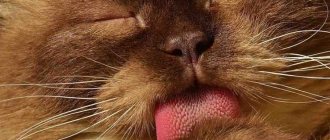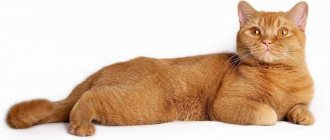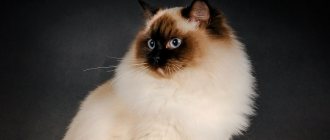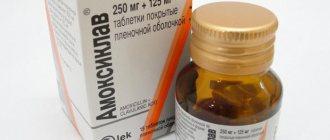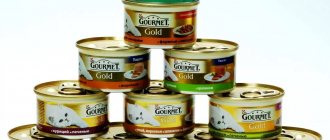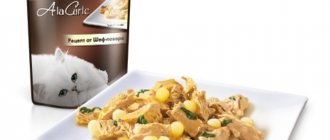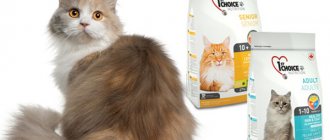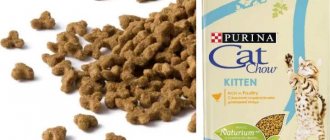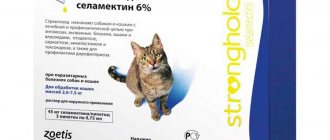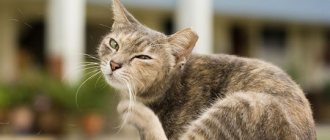A detailed guide on how to choose hair removal paste for cats. How much to give and when will the effect occur? Is it safe for pets?
Malt paste for cats is a food additive with a therapeutic effect that helps your pet remove hair from the stomach and intestines. Cats constantly lick their coats and swallow hairs - humans are unable to stop this process. These hairs inside the animal's body collect into hairballs - bezoars.
Over time, the cat's stomach becomes clogged with these hairballs - the animal's appetite decreases and vomiting appears. If lumps from the stomach enter the intestines, constipation and even intestinal obstruction may occur. Constantly brushing the fur with a furminator without the use of special products cannot completely solve this problem.
We analyzed the market offers for hair removal pastes, compared quality characteristics, compositions and prices. The result of our work is this article. From it you will learn which pastes are better, how to use and store them correctly, and whether they have any contraindications.
The dangers of excessive licking
Excessive licking of fur, accompanied by regurgitation of pieces of it, indicates that the cat has problems. If a pet licks itself until a small bald spot appears, then in places where there is no hair, infection may occur. This makes cats begin to lick themselves even more diligently. This creates a vicious circle, from which it is very difficult, but necessary, to get out.
What is hair accumulation in a cat's gastrointestinal tract?
During the washing process, the cat's rough tongue catches some hairs and swallows them. They consist of dense keratin, which is poorly digested in the gastrointestinal tract. The hairs, together with protein, mucus and other substances, form dense formations resembling stones - trichobezoars. They can be located in various parts of the gastrointestinal tract (GIT) and cause discomfort to the cat.
A large trichobezoar is usually removed surgically.
The most common breeds that have this problem include:
- Maine Coon;
- Persian cat;
- Turkish Angora;
- American Longhair;
- Cymric;
- British Longhair;
- Neva Masquerade;
- Norwegian forest
Unfortunately, not only long-haired cats are susceptible to this problem. I have two pets at home: a half-Persian with long hair and a Sphynx. The hairless cat loves to lick her furry friend, as a result of which she also swallows individual hairs. This, in turn, causes the development of trichobezoars in the Sphynx's stomach. In order to prevent such a situation, it is necessary to wean the cat from helping the cat wash itself.
Photo gallery: long-haired cat breeds
Persians have thick fur and a fine undercoat.
The Maine Coon's coat is very long, which makes it more likely to swallow
Neva Masquerade is prone to frequent shedding
The British Longhair cat also suffers from trichobezoars
What is dangerous about the accumulation of hair in the stomach and intestines of a pet?
Wool, accumulating in the digestive tract of a pet, can cause the development of serious diseases. This is directly related to the fact that the cat cannot remove most of the fur on its own (a small amount is removed by vomiting). The most common complications include:
- Gastrointestinal dysfunction. Trichobezoars are not digested and are not broken down by enzymes of the stomach and intestines, which leads to the development of dyspeptic syndrome (vomiting, diarrhea, gas formation).
- Intestinal obstruction. If hairballs block one part of the digestive tract, a life-threatening condition develops. The obstruction is accompanied by severe pain; the cat cannot fully go to the toilet. Such intestinal damage can lead to necrotic changes in the mucous membrane and subsequent blood poisoning.
- Development of gastritis. When a trichobezoar is in the stomach, it constantly secretes a large amount of gastric juice rich in hydrochloric acid enzymes. They do not damage the stone, but contribute to the formation of pathological changes in the gastric mucosa.
Symptoms of the development of the disease
During the first few weeks, the accumulation of fur in the cat's digestive tract occurs without clinical manifestations. After the formation of large trichobezoars, attentive owners notice the following symptoms:
- Changing the cat's behavior. The furry pet refuses to eat, sleeps a lot, practically does not play, and prefers to hide in inconspicuous places. Some animals can become aggressive: in response to an attempt to caress or stroke them, they attack a person, which is a manifestation of a protective instinct.
- Sickly appearance. The cat's previously smooth and fluffy fur falls out in clumps and looks dirty and unkempt. The claws begin to peel off, the whiskers break. In case of prolonged refusal to eat, the animal’s body becomes painfully thin: bone protrusions are sharply outlined, the volume of muscle mass decreases. When weighed, it turns out that the pet has lost from 2 to 5% of its weight.
- Dyspeptic phenomena. The cat often vomits small balls of hair, undigested food with gastric juice. The furry baby suffers from constipation, which manifests itself in the form of a prolonged absence of feces. The feces become rocky and sometimes contain blood collections or small trichobezoars. The cat's belly increases in size, due to gas formation, rumbling and extraneous noise may be present, and drooling is observed.
- Phenomena of general intoxication. When a trichobezoar exists for a long time, it is perceived by the furry pet’s body as a foreign object: inflammation develops. It is manifested by an increase in the cat’s body temperature (dry and hot nose).
One of my friends has a Neva masquerade cat living in a private house. One day, the owner noticed her pet’s gradually rounding belly and took her to the vet, suspecting pregnancy. The doctor performed abdominal palpation and ultrasound examination for a more accurate diagnosis. It turned out that the cat had a huge trichobezoar in her stomach, which caused the development of all the symptoms. To avoid intestinal obstruction, the veterinarian decided to perform surgery. The accumulation of hair was removed from the pet's body, and the cat began to feel well again.
Video: the doctor talks about the accumulation of hair in the cat’s gastrointestinal tract
Symptoms of the presence of hairballs in a cat's stomach and what it means
Some symptoms can indicate that a cat's stomach is filled with fur. The most basic of them is lack of appetite. Food simply cannot fit into a full stomach. In this case, the pet usually walks around the bowl, but does not eat anything. This is due to the fact that the brain simultaneously receives signals about low glucose levels and a full stomach.
There are also symptoms such as:
- loss of shine in wool;
- cough, frequent vomiting;
- accumulation of hair on the fangs;
- lethargy, fatigue and apathy towards everything;
- constipation lasting several days.
What are the dangers of hairballs?
Hairs in the GI tract become a real health hazard when they form a clump that is too large to pass through the sphincters that lead from the esophagus to the stomach, and from the stomach to the intestines. In the language of professionals, such formations are called trichobezoars (hairballs in English). They threaten the cat with the following complications:
- Loss of appetite. A lump in the stomach gives a constant feeling of fullness; as a result, the pet is less likely to go to the bowl of food and does not receive enough nutrients.
- The normal digestive process is disrupted, trichobezoars irritate the mucous membrane, causing spasms and constipation.
- In rare cases, a trichobezoar can lead to obstruction in the small intestine.
How to get fur out of your stomach
The main mistake of the owners is to let everything take its course. This can lead to the most disastrous consequences, so it is necessary to take the necessary measures as soon as you notice signs of hairballs in your cat’s stomach. This can be done at home without the use of drugs. Grow special healthy grass at home or let your pets go for walks more often, feed them with special food for removing hair.
However, today one of the most effective methods is a paste for removing hair from cats. It smells pleasant for cats, and also contains ballast substances and vegetable oil, improves digestion. You don't have to forcefully try to feed your pet the medicine.
Dosage, application, storage
Before giving your pet malt paste, you should consult your veterinarian. He will select the most suitable remedy, prescribe a course of treatment, and advise the dosage.
When is it prescribed?
The instructions for use of hair removal preparations indicate that the paste is prescribed for the following indications:
- Constipation.
- Loss of interest in food.
- Intestinal obstruction.
- Vomiting.
- Nausea.
- Weight loss.
- Changes in behavior: anxiety, anorexia, lethargy.
All these signs indicate disturbances in the cat’s gastrointestinal tract. For preventive purposes, a course of the drug is prescribed, starting from the first molt. This is especially true for long-haired pets.
How to give malt paste
In veterinary medicine, there are two main schemes for prescribing hair removal drugs:
- Daily. Daily dose – 3 cm.
- Monthly, weekly course. Daily dose – 5-6 cm.
During the period of seasonal molting, pastes are prescribed once a day, 5 cm. The drug should be given until the process is completely completed. To speed up coat change and alleviate the pet’s condition, it is necessary to regularly use a slicker during this period.
For constipation and vomiting, a single use of the drug in an amount of 15 cm is possible.
The required amount of product is squeezed out and given to cats by hand, applied to the animal’s paw and face, or mixed into food.
When to give?
It is best to give the drug before meals or 1.5 hours after meals. It is recommended to comb the animal first.
Important!
Don't expect a lightning-fast effect - the paste takes effect after a while. But the effect may occur after the first use.
How to store the drug
Unopened packaging of the drug is stored in its original packaging at room temperature (15-25°C) in a room with normal humidity. The opened tube is tightly capped and placed in the refrigerator (2-8°C). The shelf life of the drug if stored correctly is 2 years.
What is malt paste
Malt paste is a mixture for removing trichobezoars (the scientific name for hairballs). It has an enveloping effect and a pleasant smell that attracts cats. Basically, malt paste contains the required set of components:
- lipitas;
- proteins;
- fiber;
- ash substances.
Some pet product manufacturers add other components that help increase the effectiveness of the medicine.
Cliny paste for cats - reviews
This hair removal product is very popular, so there are numerous and mostly positive reviews about Cliny paste for cats. We've shared a few of the ones we found below.
Customer Reviews
Zhanna writes:
After using the paste, the result is obvious, the cat does not vomit shreds of fur. We have been using the paste for about 2.5 years. The paste keeps well (I kept the tube I started in the refrigerator door for half a year).
I don’t give it every day, a couple of times a week, a couple of times every two weeks, a month... depending on the shedding. But, no side effects were observed. The cat eats from the plate with great pleasure, I squeeze out 5 cm of paste, he licks it off. The cat can also lick from the tube, but I think that this is not very hygienic (I gave it to him only for the photo).
The paste liquefies the fur in the stomach, is excreted naturally, with feces, so it does not accumulate in a lump in the stomach, the wool does not become compressed, and blockage of the stomach is dangerous for the life of the animal. The paste has a pleasant sweetish malt aroma. In the photo there is a Scottish cat, 3 years, 2 months.
Olga writes:
The cat is delighted, and if you give him the paste regularly, there will be no problems with his fur. Even though he has very long hair. And it is quite profitable to buy such a volume.
Ella writes:
In my opinion, the most budget pasta of all. This is not the first year I have been buying it. It’s especially cool that there are large tubes (not all stores have them). Kittens love this paste very much.
Which hair removal paste to choose: the most effective
Pet stores and veterinary pharmacies offer many different pastes for hair removal. Before purchasing one of them, read the instructions, paying special attention to the composition and possible side effects.
Below are the best malt pastes for cats, in our opinion.
Cliny
Malt paste from the domestic manufacturer Cliny can be bought at any pharmacy and, if compared with imported products, this is not only high-quality, but also inexpensive (45 grams - 250-280 rubles). One of the advantages is the attractive smell for cats.
Gimpet
Gimpet paste is also relatively inexpensive (200 grams - 700-800 rubles). Contains natural aromatic malt and vegetable oil, has a brown color and a pronounced odor that attracts cats. This paste is one of the most popular and effective according to customer reviews. The advantages include the smell and lack of sugar.
Gimcat
Gimcat paste has an average price of 610 rubles per hundred grams. The composition is identical to Gimpet, the only difference is the instructions, which require 1 cm more paste. For some owners, this turned out to be a significant difference. The advantages include high efficiency and smell.
Beaphar
The price of Beaphar paste is similar to Gimca (500 rubles for 100 grams). The composition includes oils and fats, milk and dairy products, and products of plant origin. Removes bacteria from the animal's body. The advantages of Beafar paste include improved wool quality and the addition of caramel to improve taste.
Sanal
Sanal malt paste has a pleasant meaty taste, contains vitamin E, has a pronounced preventive effect, and improves appetite. The price is more than suitable for every buyer (170 rubles per 20 grams).
Stop problem
The “Stop Problem” paste is also domestically produced. The composition includes wheat bran, corn oil, milk powder. Sarbic acid is used as a preservative. It is worth noting that the Stop Problem malt paste is a cheap analogue of the Cliny paste.
Kittymalt Hairball Remedy
Kittymalt Hairball Remedy paste contains vegetable oil, vitamin E, salmon oil, glycerin. The price suits the buyer (210 - 240 rubles per 100 grams). One of the advantages is the pronounced fishy smell, but not all cats like it.
Composition and principle of action of the paste
The main components of modern hair removal products are vegetable oils and fats, fiber, microcrystalline cellulose, dairy products, malt concentrate and ballast substances.
Some formulas have added TGOS - transgalactoolisocharides, which stimulate digestive activity and normalize the microflora of the large intestine. Recipes for combined products contain vitamins, absorbents and disinfectants, minerals and amino acids.
Operating principle of malt pastes
Hair removal products do not dissolve hairballs, but help remove them from the animal’s body.
Their second function is preventive. Pastes do not allow hairs that have entered the cat’s stomach to form large bezoars and grow into the intestinal walls.
How does this happen?
The malt and oils included in the formula of paste preparations envelop hairballs stuck in the animal’s gastrointestinal tract - this makes it easier to remove them out.
Wool is excreted from the cat's body with feces in an undigested and undigested form. In addition, the paste lubricates the intestinal walls, facilitating bowel movements.
Fiber and vegetable fats stimulate peristalsis of the intestinal wall - this normalizes stool and prevents constipation. Activating the intestines has a beneficial effect on the pet’s well-being, improves appetite, and prevents vomiting.
Pastes enriched with micro- and macroelements have a healing effect on the cat’s body:
- increase immunity;
- normalize the functioning of the liver and kidneys;
- improve wool quality;
- replenish reserves of micro- and macroelements.
Pros and cons of malt pastes
Advantages:
- Pleasant taste. Animals willingly eat the medicine.
- Effectively relieve constipation.
- There are no contraindications based on the age or condition of the animal.
- Compatible with other medications.
- Easy to dose.
- Do not cause addiction or allergies.
- Convenient to give along with food.
- The therapeutic effect is noticeable immediately.
The disadvantages of the product include the need for storage in the refrigerator and a long course of administration.
Important!
The formula does not contain addictive components, the active substances do not accumulate in the pet’s body - the drug can be used for a long period.
Preventive measures
To avoid re-clogging, doctors advise using special pastes and mineral supplements during shedding. This product helps remove villi from the stomach in a short time by stimulating regurgitation. In addition, it is worth adding food rich in sulfur, magnesium, and folic acid to your cat’s diet.
Hairballs in a cat's body are a common problem that animals encounter during the shedding process. A timely response to pathology on the part of the owner helps prevent the development of complications and the inflammatory process.
Pet care
It is worth remembering the rules for caring for your cat during therapy. If the cat cannot regurgitate fur during treatment, what to do and how to remove it:
- provide the animal with plenty of fluids with added oils;
- comb the cat's shedding fur so that she does not do it on her own and does not expose her intestines to another blockage;
- Monitor your pet’s diet and feed it food containing plant components. Such food helps to fill up and enrich the intestines with useful substances.
To avoid infection, it is recommended to monitor your cat's hygiene.
